Home
Ren's Biking Blog
CBF 125 No Lights - Again
Blog Date 30 November 2016
Argh! 5 miles from the end of my 25 mile commute, down a dark and damp lane and navigating a sharp left hander I'm plunged into an even dimmer twilight world than the usual one the terrible 125 headlamp typically produces. Damn. Drat. Poop. Bummer.
Thankfully all is not *quite* lost. The CBF125 electrical system manifests itself differently to most other motorcycles. For reasons unknown (presumably price) my 125's headlamp, side light and rear tail light are powered directly from the alternator. As such if you stall the bike these lights go out. The indicators will still work as will the brake light because these are fed from the battery. Fearing that one day I may loose the engine while sat at a dark junction or such like I have fitted a bright "position" LED light at the front and a small red LED light at the rear to supplement the existing lights.
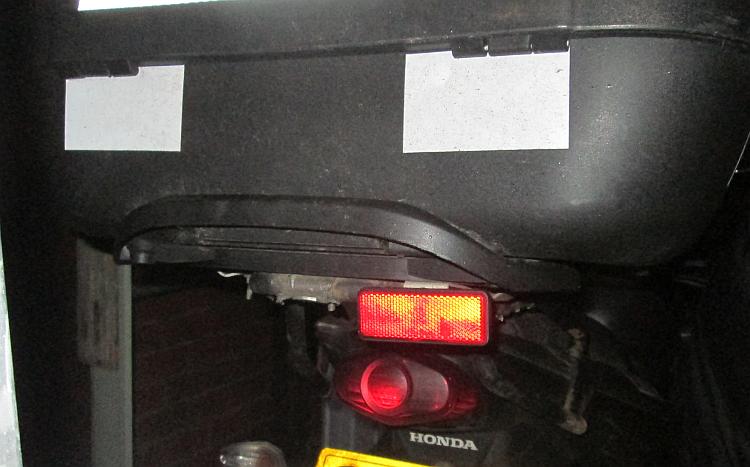 The reflector is actually an LED tail light for, you know, just in case.
The reflector is actually an LED tail light for, you know, just in case.
My foresight means while the primary headlight is defunct and presumably the tail light too, I still can be seen with my reserve lighting and the minimal illumination from the front LED is sufficient to allow careful navigation back to street lit roads. A car threatens to pull out on me, I shall forgive her as she probably thought I was a cyclist doing 15mph rather than a motorcyclist doing 30mph.
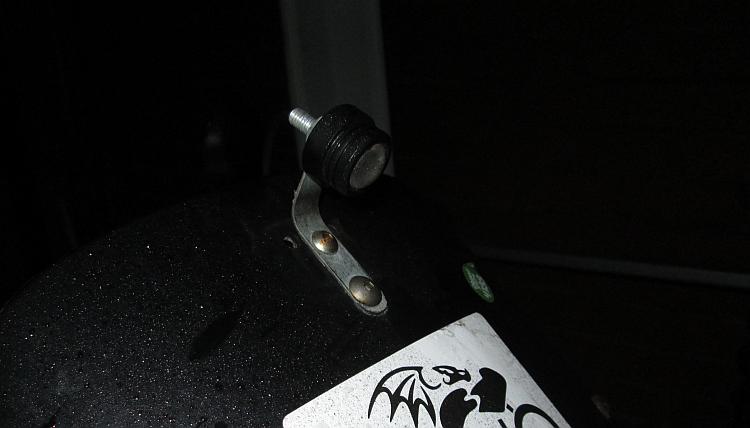 This is a small but piercingly bright LED at the front. I point it down to avoid dazzling road users.
This is a small but piercingly bright LED at the front. I point it down to avoid dazzling road users.
So what is the issue? I've been here before although this time things are subtly different (CBF 125 Alternator-Stator Problem and CBF 125 Alternator Noise - No Lights). Last time when the alternator failed it made a most peculiar and ghostly noise, a faint "oooooooooo..." that rose and fell gently with the revs. That noise is not present this time.
So as far as I can see there's 3 possibilites.
1. Broken wire - short - loose connection. Perfectly possible and the obvious thing to check before I start shelling out cash. 7 year old 125s with 58,700 miles on them are likely to suffer corrosion in the wires, wires rubbing their insulation away at vibration points, connector blocks working loose or even just a popped fuse! I'm hoping it's as simple as this and can be fixed with a soldering iron and insulation tape. I'm doubtful though.
2. Regulator - rectifier. Urgh. This certainly won't be the first time a reggy/reccy has let me down. I have reason to think this could be it as the last time the alternator fried I changed the reggy/reccy as a matter of precaution. That was around 30,000 miles which means this present item has covered 28 to 29 thousand miles. Perhaps the charging system last for around 30k before it dies. A new one will cost me around £50.
3. Alternator (Stator). Double Urgh. I have just a hint of doubt that it may not be this in that it's not making the same noise as it did last time. This DOES NOT preclude it from the list though. A new one from Honda is £170, there's some pattern part on Ebay for £70. Do I take a punt on the cheaper item? Let's see if the reggy/reccy does the trick first if it's not a wiring issue.
In the meantime I'm thankful I fitted the reserve lighting. I'm thankful I have the use of my other bike, the 500. I'm mildly frustrated that something's broken on the 125 but come on, give it a break, it ain't doing bad for a much abused high mile hack. What is really upsetting is my shiny new 500 is covered in a thick layer of winter road salt. ARGH!
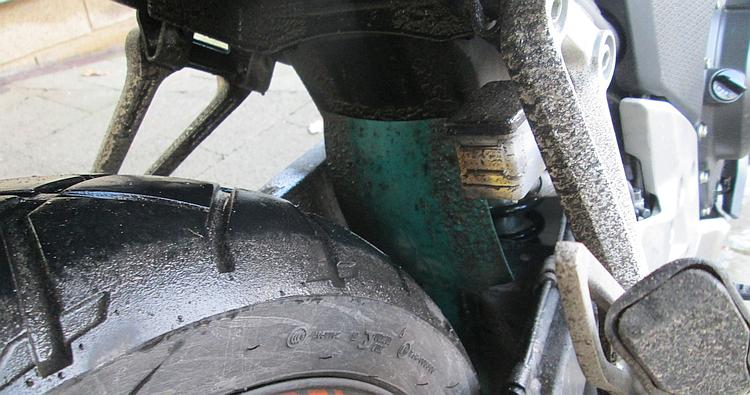 Urgh...I'll have to hose that off.
Urgh...I'll have to hose that off.
Reader's Comments
Ren - The Ed said :-
Nope. No broken wires. Also no measurable resistance from the stator coils. Also burnt insulation on the stator coils. Bummer. It's the stator isn't it. I've ordered the cheap £70 stator from Ebay rather than a genuine Honda one.
Wish me luck...
02/12/2016 10:27:56 UTC
Ren - The Ed said :-
The burnt bits on the stator...pffffft
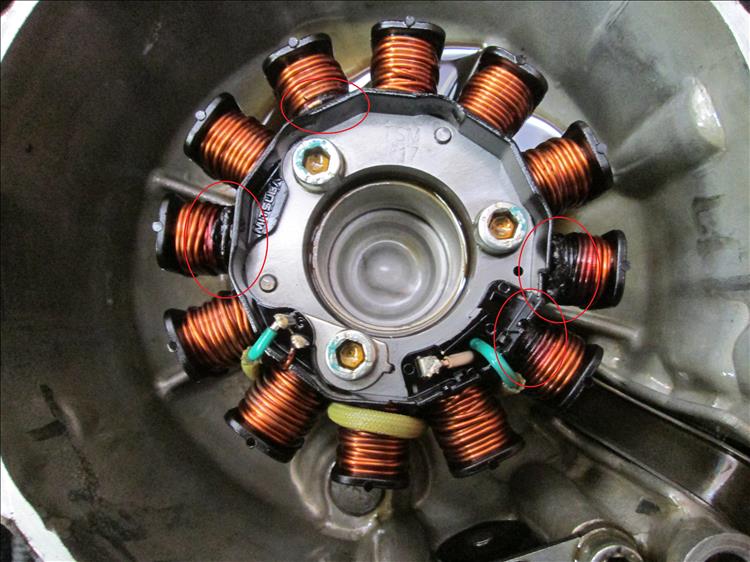 02/12/2016 10:40:03 UTC
02/12/2016 10:40:03 UTC
Henrik said :-
How comes this ? bad coil-work from the start ?
02/12/2016 12:31:12 UTC
Ren - The Ed said :-
Hi Henrik. I'm guessing that because it's happened twice to me and there's a lot of similar posts on various forums that it's a common issue with the CBF 125.
According to my Haynes manual the alternator can produce 170 watts.
The headlight is 35w, tail light 5w, brake light 21w and indicators perhaps 21w each giving a potential maximum drain of 103w for the lighting. I do not know how much power the fuel injection, fuel pump and computer use but it's possible the alternator is underpowered a little. Throw in recharging the battery after starting or even worse after me charging mobile phones, tablets and torches I'm sure it's overworked.
I now have 2 dead stators. I'm wondering if there's a way to reqind one of them to increase the output. I know NOTHING about how to do this and what effect (if any) it would have on the rest of the bike.
02/12/2016 16:20:12 UTC
Latchy said :-
You may find the after market stator has a greater output, mine did ( remember the zzr600 saga) the manufacturer of that stator claims an extra 15% compared to the original one, which should help with my brighter headlamp bulb and heated grips
03/12/2016 09:04:43 UTC
Ren - The Ed said :-
I hope so Latchy. More importantly I hope it lasts a long time. There's a part of me that wanted to stick with Honda for original quality. Although the original quality piece from Honda has obviously not got much original quality! I guess I'm going to find out one way or another.
03/12/2016 09:10:20 UTC
Ian Soady said :-
My old SP400 had a similar hybrid system, with the headlight fed direct from the alternator. So the headlight effectively went off when you slowed down (a bit like old Ford cars which had wipers "powered" by induction vacuum. They worked furiously when you were sat at traffic lights and the like only to virtually stop when you had the throttle wide open....)
My long term plan (if some unpleasant person hadn't decided to relieve me of the bike one dark night) was to rejig the system to regulate and rectify the whole of the output and feed the headlight from the battery. It shouldn't be too hard (he said from the comfort of a nice warm house).
ps some of my posts seem to be vanishing again. Once is happenstance. Twice is coincidence. Three times is enemy action.........
Or maybe I'm just getting the number wrong.
04/12/2016 10:54:35 UTC
Ren - The Ed said :-
Ian - re posts vanishing. The page is programmed such that if you post a post when completed successfully the "Thank You" image should appear. If not you'll find yourself at the top of the page.
So when you say your posts are disappearing do you successfully see the post on the page then a while later it has gone...or you type away only to find it never makes it on the page immediately after clicking "Submit"
When I get a moment I shall endeavour to reprogram such that if the number is typed incorrectly it will tell you so rather than just doing nowt.
04/12/2016 15:43:56 UTC
Ren - The Ed said :-
And regarding the making the whole thing run off the battery. That's a common conversion for CBF125s but some technical folks suggest this may not be the best idea.
I am NOT an electronics expert. What I can deduce is there's 1 single wire coming from the coil to the reggy/reccy. There is one earth to the reggy/reccy. Coming "out" are a red/yellw wire that goes straight to the battery which I assume is DC regulated. One other wire, a yellow, feeds the headlight, tail light, clock lights and side light. Apparently some people call this AC but those in the know say it's actually DC pulsar or unsmoothed.
I actually *think* I understand. The one to the battery will be one half of the alternator's wave but smoothed out presumably by a capacitor. The unsmoothed will the other half of the alternator wave but without any smoothing. ie. it's DC but pulsating hence the name.
One mod suggests just ignoring the unsmoothed output and wiring the lights to the battery. This may be bad as the DC smoothed circuit is overloaded.
Another mod is to feed both the smoothed and unsmoothed to the battery. This spreads the load but I'm doubtful batteries are designed to work with sunsmoothed pulses.
As such I ain't changing anything until I know a lot lot lot lot more.
04/12/2016 15:55:38 UTC
Doug said :-
170 Watt alternator? Luxury! I think that's about 80W more than the Enfield's :-) It doesn't have to contend with those new fangled starter motor/fuel injection fuel pump things though, and since I've gone LED on the rear lamp, brake and indicators, there's a few of those Watt things spare for LED spots. I like the LED reflector you have, might get one for the YBR's top box.
04/12/2016 22:13:40 UTC
Doug said :-
I just remembered, my first Enfield (2004 Electric start 500) had AC lights, was quite disconcerting when switching from dipped to main and back again, you had about a second's worth of darkness. Much prefer the older 350's all DC setup.
04/12/2016 22:20:03 UTC
Ren - The Ed said :-
To be honest Doug the LED reflector thing was something cheap from China. As such only about 8 of the perhaps 20 LEDs worked. Enough to be seen but don't be expecting a smart and stylish look. Maybe there are better quality ones but tread carefully.
I'm guessing the reason Honda and any other marque would do this AC or unsmoothed or pulsed DC malarkey would be cost. I struggle to imagine what difference it makes though. I'm trying to imagine a setup on my 125 where I can somehow attach a car alternator. Car alternators are cheap, readily available and seem fffffffar far more reliable. I wonder if I could run a pulley off the front sprocket and mount the car alternator just behind the piston...
05/12/2016 08:49:43 UTC
Bob said :-
Typically this electrical arrangement is used because it is cheap and physically smaller. The single wire to the reg/rec is indeed AC and the reg/rec turns it to half wave rectified AC. The battery performs the job of smoothing out the waves to give a DC voltage on the battery powered bits of the loom. Often these systems are actually unregulated, the power O/P of the coil is matched to the load of the battery and the average load of the indicators and brake light etc.
The other wire from the alternator is also AC, that's what alternators produce, and this powers the lights directly. Once again, the O/P of this coil is matched to the load of the headlight and the tail light and no regulation is used. This is why when the headlight bulb blows, if you keep going the tail light usually blows too. Without the load of the headlight the voltage becomes too great and too much current flows in the tail light.
If you're having repeated failures of the coil it may be because it's overloaded, check that you're running the correct wattage headlamp bulb and that nothing else is wired into the lighting circuit. Alternatively it might just be that the alternators are crap....
05/12/2016 12:11:39 UTC
Ren - The Ed said :-
Hi Bob.
Having looked around the forums and what you have said I'm just simply confused. Some folks reckon that the alternator just pumps out power and the reggy reccy dumps the unwanted power. Therefore a larger load (more lights or heated grips) lessons the load on the reggy reccy. Others like yourself suggest the more load the harder the alternator is working and therefore more likely to burn out.
Personally I'm with you - I am sure the VOLTAGE increases from the alternator with revs but the CURRENT is whatever the circuit requires. However current times voltage = wattage (power). So if there's more load there's more power being drawn from the alternator. If I put the lights on in my car at tickover the revs drop just a tiny fraction as the alternator feeds more power for the lights.
It is possible there's too much load. There's the additional LED lighting but that will be miniscule. I reckon my problem is two-fold. Firstly charging phones and tablets overnight while on my trips. I know this drains the battery and that energy must be replaced.
Secondly the motorway riding. I could be wrong here, however... At low revs let me say the alternator is producing 16v at a current of 1 amp. At motorway speeds the alternator is producing 30v at 1 amp. That extra voltage and therefore extra power has to go somewhere. Some people suggest that's what the cooling fins on the reggy reccy are for, that's where the unrequired power is dumped. Other people seem to think that it's somehow shunted back into the alternator coils.
After 58.700 miles I have changed the headlight bulb twice and the tail light bulb is still the original. The battery is still the original. I don't *feel* as though there's anything amiss save for what is probably a poor or underspecified alternator stator.
The replacement is fitted and all is well...so far.
05/12/2016 14:40:31 UTC
Bob said :-
Umm, where to start.
The voltage on the alternator O/P is a result of the O/p impedance of the alternator connected to the I/P impedance of the lighting circuit (which will change depending on what lights are on at the time).
If you have connected LED lights across your lighting circuit that won't be doing the alternator any good since they are effectively short circuit half of the time. IF the LED lights are on the battery circuit then that's fine.
A lot of people on a lot of forums talk utter cr*p about alternators and reg/recs, very few now the truth.
In the old days a three phase alternator had a zener diode to clamp the peak voltage of each phase to 12V, these zeners worked by dumping excess power as heat. A modern charging system employs an SCR or TRIAC type switch, the three phases are first rectified through a diode bridge and then the regulator controller switches through part of the rectified wave whilst monitoring the loom voltage. The battery is used to smooth out the rectified AC which is passed out of the Reg/rec. If the loom voltage falls, a larger portion of each wave is switched through.
Check your battery voltage with a meter set to AC, with the engine off you'll see 0V, with it running you may see up to 30V - proof that the battery is being fed rectified AC.
Anyone who suggests that the Reg/Rec dissipates more power when the lights are off and the load is light, than when they are on and the load is heavy is wrong.
Reg/Recs have fins because no semiconductor is perfect and whilst it is supposed to act like a switch, the TRIAC has a little bit of resistance and therefore dissipates some heat. The more current passing through the TRIAC the more heat it will dissipate.
The new breed of MOSFET reg/recs are better because the MOSFET devices have a lower resistance than the older TRIAC types and therefore dissipate less heat and pass more power to the battery.
05/12/2016 15:19:55 UTC
Tony said :-
Hi Bob, that's some fascinating stuff and thank you for the insight. I've gone away and thought very long and hard about what you've written. I doubt very much though that the general handyman will own a multi meter capable of reading 0VAC on a battery, those start nearer the £100 mark.
05/12/2016 23:06:42 UTC
Bob said :-
Any cheap £10 DVM will have a VAC and VDC setting.
Put it on AC and measure the battery, obviously with the engine off you will see 0V. But when the engine is running you will see a large AC value, this is the meter showing that the voltage coming from reg/rec is not a constant 14.5V (or thereabouts) but is in fact a series of rectified half-waves coming from the alternator. If the meter has a "Hz" setting you'll be able to see the figure increase with the engine RPM too.
Even better is to use an oscilloscope, that will show you exactly what's going on - that's how I know!
06/12/2016 10:22:39 UTC
Ren - The Ed said :-
OK..so looking around on the interweb I learn a little about MOSFETs. Basically they're a switch. When the switch is open the voltage on the battery charging side goes up and up and up until it reaches a set value, say 14.5v. When this value is reached the electronics say "whoa! that's enough" and close the switch. The voltage in the battery charging side starts to drop. It drops and drops and drops until it reaches lets say 12v. The switch is opened once more.
I'm guessing this all happens incredibly quickly, perhaps hundreds of times per second even?
So in my head there's a little man inside the regulator part of the reggy reccy. He's got a multimeter. He sits there switching the MOSFET on and off trying to keep the voltage between set values. As such the battery doesn't get a steady 14.5v it receives lots of little short pulses. on-off-on-on-off-on-off-on-on-off-on-off-on-on-off-on-off-on-on-off- and so on.
The battery is a big fat lump of electricity. It absorbs these pulses like a shock absorbs bumps on the road. The rest of the components like lights and computers only feel teeny little pulses because the battery has taken most of the rough stuff up.
Am I getting there?
06/12/2016 12:15:11 UTC
Bob said :-
Sort of yes, the MOSFET switches through more or less of the wave as the battery voltage falls and rises and this happens very quickly. If the bike has a three phase alternator there will be three complete cycles per engine revolution.
When the MOSFET is on the current flows from the alternator coil into the battery, when the MOSFET is off the voltage on the alternator side of the battery builds (because there's nowhere for the alternator O/P to go) but there is no current flow and hence no power dissipated in the alternator. This idea that the MOSFET shorts unwanted power to ground is ludicrous and as I say I think it comes from the old days of Zener regulators.
Therefore as you'd expect, when there is little electrical load on the generator it is under least strain and dissipating the least heat and when everything is on and using power the generator dissipates the most heat.
You are spot on about the function of the battery in this system.
06/12/2016 15:05:51 UTC
Ren - The Ed said :-
It doesn't help when businesses trying to sell their product make videos like the one I'll put in the link.
Simply put at around 34 seconds the video it shows the flow of electricity being switched from the battery to ground. This makes folks like me thing the reggy reccy just dumps the flow when it's no longer needed.
Having watched several other videos about MOSFET semiconductors with detailed explanations of "N" and "P" boundaries and gates it becomes clear the MOSFET and most other similar semiconductors simply switch things on and off, just as a light switch in my house does. A light switch doesn't send the energy in my wires to ground and to waste, it just simply stops the flow of energy!
www.youtube.com/watch?v=mEr6xSGLC48...
06/12/2016 18:56:57 UTC
Stuart said :-
It does amaze me just what is going on when I start up my bike. When you think of all of the above as well as pistons, cams, gears etc it's a wonder they don't break down more often.
I think I'd better go and see if mine still works!
Stuart
07/12/2016 07:42:18 UTC
Bob said :-
MOSFETS are usually used as an on/off switch as you say. When "off" there is no dissipation because there is no current, when "on" there is a little dissipation because there is an "on" resistance but manufacturers strive to keep this as low as possible, typically a few hundred milliohms or less.
MOSFETS are used in the "middle ground" in audio amplifiers, where it's not just on and off, in this mode a lot of heat is dissipated - look at the fins on the back of a guitar amplifier.
It may well be that some systems dump the current to ground, different manufacturers have different ideas on how to do things, but the ones I've looked at don't.
07/12/2016 12:25:14 UTC
Ren - The Ed said :-
Stuart - I quite agree! It is stunningly amazing that a vehicle reaches the end of a driveway let alone the end of the road. To boggle your mind if my 125 runs at 4,000 rpm at 30mph, in one hour and 30 miles the crank will have rotated 240,000 times. So to cover 300 miles means 2,400,000 rotations. to do 3,000 miles equates to 24 million rotations. My 125 has 58,800 miles. At 60,000 miles the crank may have done 480 million rotations.
Bob - again learning as I go there's a lot of regulator rectifier diagrams that show the SCR (kind of like an simpler early MOSFET in case readers don't know) switching to ground. I wonder if some do and some don't. The obvious question would be WHY? Why waste energy and create heat.
Is it possible these people are still stuck with old adapted Zenor Diode diagrams? I'll add a link as an example.
racetechelectric.com/ft-751-voltage-regulators.html...
07/12/2016 15:05:44 UTC
Bob said :-
I found that same Racetech link through google.
Right, this is winding me up now. I'm going to test it. Simple method - put an ammeter in line on one of the three phases from the alternator to the reg/rec.
If everybody else is right and I'm wrong there will be exactly the same AC current flowing whether the lights are on or off.
Even typing it out it sounds wrong, these folks are contending that in the case of a 200W alternator there will be 5.5 Amps flowing in each of the three phase wires all the time, regardless of load.
Anyway- I'll run the test and post the results.
07/12/2016 15:51:26 UTC
Ren - The Ed said :-
I'm still with you on this Bob. Why oh why oh why would you throw energy away rather than just switching it off? Let's hope that you're right. And if you're not then how's about we make our millions by creating reggy reccys that DON'T throw energy away?
I wait with baited breath.
07/12/2016 16:16:36 UTC
Henrik said :-
A switch function can be performed with a MOSFET, yes, however its realy on par with a normal transistor, and thus will do all the usual analog stuff as well, MOSFET power-amplifiers have been produced for decades, I am looking into the TDA7293 these days, fancy little MOSFET based amplifier,..
Stators are blowing up on the Hyosungs as well, all of them, on certain models there can be exchanged to a certain Stator from Suzuki, but not on mine, I am planning on having a spare one with me on trips, to very remote locations, just in case, got no road-help,...
www.eeweb.com/blog/extreme_circuits/dual-power-amplifier-using-tda7293-mosfet-ic...
10/12/2016 21:55:04 UTC
Ren - The Ed said :-
How far can you go with the spares though. Spare tyre? Spare regulator/rectifier? Spare engine cases? Spare handle bars? It seems that alternator stators are weak, there's plenty of problems across all makes and models.
Are you planning any big trips on the Hyosung?
12/12/2016 11:21:01 UTC
Henrik said :-
Hi, not any big plans but Norway is always ony mind, one way or the other, for 2017 a series of small 1-2 day trips in south Sweden is most realistic, will not make any big plans, more working at the badsics for long-term possibilityes, lifying one leg at the time, at least there is roof, first floor, and fireplace soon finished in the house. Econnomy is also to be considered, a new car within the next 1-2 years, cash, we will make it a caddy, berlingo, or lodgy, they are not free :-)
12/12/2016 12:13:08 UTC
Henrik said :-
Damm that spell-controll :-)
12/12/2016 12:14:37 UTC
Ren - The Ed said :-
Don't worry about the spelling Henrik. It sounds like you're so very busy spelling is the least of your worries. I hope it all comes together for you and you still find time to ride.
12/12/2016 14:42:00 UTC
Darren said :-
I seem to remember, but I could be wrong, that 80's Suzukis used to burn out stators for fun if the oil was of poor quality (unchanged?)or low, I believe the oil helps keep the stator cool, maybe this is also happening with the 125?
24/12/2016 08:06:06 UTC
Ren - The Ed said :-
Hi Darren. It's a perfectly valid question, according to the forums I've read quite a few folks suggest the oil plays a big part in cooling the stator.
The oil in the CBF 125 is changed every 2,000 miles, that's more often than the recommended service interval of 2,500 miles. I do keep an eye on the oil level too. So in terms of maintenance (old oil) I don't think that's the issue.
In terms of design it certainly could be a factor. Maybe the oil sits too low in the engine to provide cooling for the stator. Perhaps there's not enough oil flow around the engine there. I wouldn't know how to test these hypothesis and even if I could I can't think of anything I could change in the engine to fix it.
Good thinking though. I suppose car alternators are air cooled, they usually have cooling fan blades on the back of the pulley.
24/12/2016 09:07:39 UTC
Sharon said :-
Now Darren's post about oil has got me thinking.
I know Ren you are not a fan on Motorcycle specific oil. Claiming that car oil in your bikes have always served you well and you do not find any difference.
However you know I myself found a huge difference in my Keeway when I used car oil as opposed to specific Motorcycle oil.
So as is my way I did a bit of research between the difference between car and motorcycle oil.
Apparently there are 6 differences between Motorcycle and Car oil. (Link below from where I got this information and for further information on the subject)
1. Operational Speed. Motorcycles tend to operate at engine speeds significantly higher than automobiles. This places additional stress on engine components, increasing the need for wear protection. It also subjects lubricating oils to higher loading and shear forces. Elevated operating RPMs also promote foaming, which can reduce an oil's load-carrying ability and accelerate oxidation.
2. Compression Ratios. Motorcycles tend to operate with higher engine compression ratios than automobiles. Higher compression ratios place additional stress on engine components and increase engine operating temperatures. Higher demands are placed on the oil to reduce wear. Elevated operating temperatures also promote thermal degradation of the oil, reducing its life expectancy and increasing the formation of internal engine deposits.
3. Horsepower/Displacement Density. Motorcycle engines produce nearly twice the horsepower per cubic inch of displacement as automobile engines. This exposes the lubricating oil to higher temperatures and stress.
4. Variable Engine Cooling. In general, automotive applications use a sophisticated water-cooling system to control engine operating temperature. Similar systems can be found in motorcycle applications, but other designs also exist. Many motorcycles are air-cooled or use a combination air/oil design. Though effective, they result in greater fluctuations in operating temperatures, particularly when motorcycles are operating in stop-and-go traffic. Elevated operating temperature promotes oxidation and causes oils to thin, reducing their load carrying ability.
5. Multiple Lubrication Functionality. In automotive applications, engine oils are required to lubricate only the engine. Other automotive assemblies, such as transmissions, have separate fluid reservoirs that contain a lubricant designed specifically for the component. The requirements of that fluid differ significantly from those of automotive engine oil. Many motorcycles have a common sump supplying oil to both the engine and transmission. In such cases, the oil is required to meet the needs of both the engine and the transmission gears. Many motorcycles also incorporate a frictional clutch within the transmission that uses the same oil.
6. Inactivity. Motorcycles are typically used less frequently than automobiles. Whereas automobiles are used on a daily basis, motorcycle use is usually periodic and in many cases seasonal. These extended periods of inactivity place additional stress on motorcycle oils. In these circumstances, rust and acid corrosion
So I found this protection are of critical concern.
Soooo is it possible that by not using Motorcycle specific oil that the oil is not cooling the engine correctly? Causing the stator to overheat and burn out?
Just a thought.
www.motorcyclepowersportsnews.com/motorcycle-oil-what-difference-does-it-make/...
24/12/2016 19:56:50 UTC
Sharon said :-
On the flip side of what I did just post there is the following article which says there is no evidence to support Motorcycle specific oils being better than Car oils.....Link below.
The trouble with research is always the more you do the more uncertain and confused you become.
www.ducatimeccanica.com/oil.html...
24/12/2016 20:38:49 UTC
Henrik said :-
7. Car-oil can make a MC-clutch slip ,.. this I hear over and over again
24/12/2016 21:02:42 UTC
Henrik said :-
Why take a chance, I get my mc-specific 10/40 from www.louis.de When they have their sales I will get a lot of them, just their own brand, ok+cheap
Several people I have known in years, and trust, all tell me to use mc-oil
Thats it, research over, why be trouble even to consider it :-)
24/12/2016 21:13:15 UTC
Ren - The Ed said :-
I'm working on an article about oil Henrik because it is such a contentious subject! Watch this space.
26/12/2016 07:26:55 UTC
Pocketpete said :-
My cb500x had an oil change at 800miles then 1200 miles with filter.
It's just clocked 4000miles thinking about another oil change. Is it worth the £40 quid. The next service is 8000miles. Will it make a difference when the service Intervals are quite far apart.
Shall I just do the oil and leave the filter till 8000k.
27/12/2016 11:03:05 UTC
Ren - The Ed said :-
Pocketpete, you won't do any harm doing an additional change. It it worth it? That's a matter of opinion, I'd say not because you have good quality recommend oil in there that should last the recommended interval of 8,000 miles.
But hey! Fresh oil is still better.
28/12/2016 09:05:11 UTC
KS R said :-
Hi. Seen you have Keeway stuff on this site. Have you got any images of the stator on that bike? Need to see if the one I'm going to buy is same. Thnx.
16/01/2019 22:55:13 UTC
Ren - The Ed said :-
Hi. I'm guessing you're talking about Sharon's RKS125? I have an image, I hope it'll be helpful.
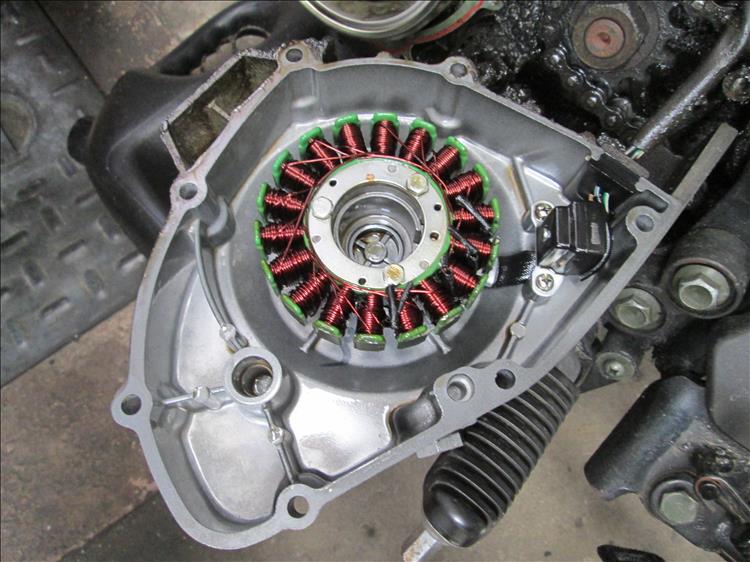 16/01/2019 22:58:47 UTC
16/01/2019 22:58:47 UTC
KS R said :-
Ace looks same. What year is Sharon rks
17/01/2019 06:35:36 UTC
Ren - The Ed said :-
It's a 2013 registered RKS 125. I'll add an image of the engine code that'll help identify the model
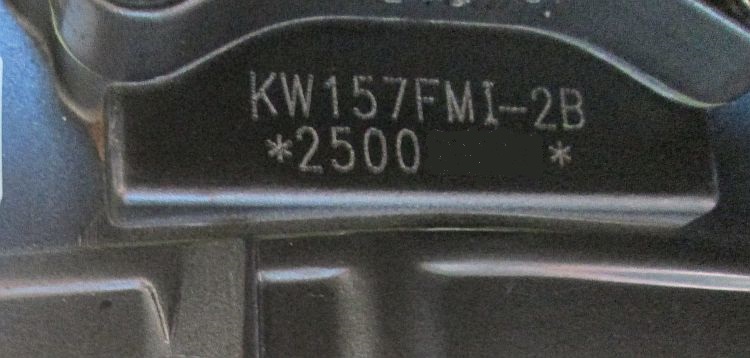 17/01/2019 09:53:39 UTC
17/01/2019 09:53:39 UTC
Jonny said :-
Hi I've got a Honda cbf 125 put all new bulbs in but the main lights only come on when I put break on wierd can any one help please
17/09/2021 20:35:54 UTC
Bill said :-
Jenny have you put a single contact bulb instead of a double in your rear light?
17/09/2021 22:09:41 UTC
Bill said :-
Jonny have you put a single contact bulb instead of a double in your rear light?
Sorry for typo of your name in 1st reply
17/09/2021 22:11:12 UTC
Ren - The Ed¹ said :-
I see where you're coming from Bill - and maybe you're right. The brake light is powered from the battery and on a separate circuit from the rest of the lights. If the brake is applied current may flow through the 2 pins of the stop/tail bulb socket being connected via an incorrect single pin tail only bulb. If memory serves the locating pins are offset in a stop/tail bulb and as such a regular single tail bulb with its pins directly opposed should not fit... but they can be forced to fit with a good shove.
Otherwise Jonny you've either got a short somewhere or someone's been messing with the wiring. Start by checking the rear bulb.
18/09/2021 18:53:13 UTC
Name
Comment
Add a RELEVANT link (not required)
Upload an image (not required) -
Uploading...
Home
Ren's Biking Blog